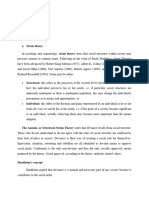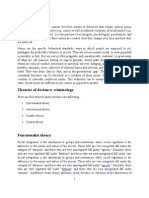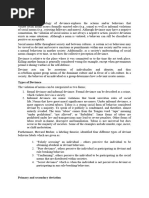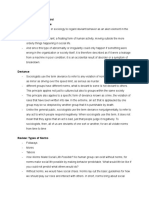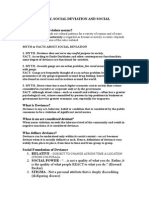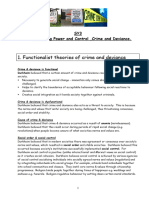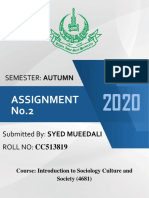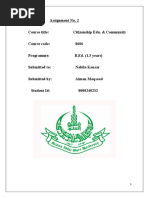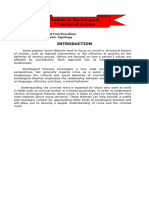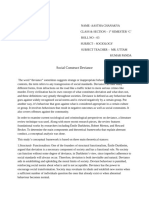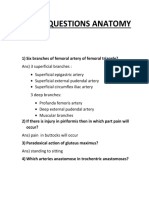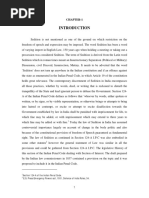0 ratings0% found this document useful (0 votes)
97 viewsDevian Behavior
Devian Behavior
Uploaded by
AhmedDeviance refers to actions that violate social norms and can include criminal behaviors as well as informal violations. There are three main sociological perspectives on deviance - structural functionalism, symbolic interactionism, and conflict theory. Structural functionalism views deviance as both necessary and normal for social organization, while symbolic interactionism examines how deviant meanings and behaviors are developed through social interactions. Conflict theory views deviance as a result of conflicts between groups over resources.
Copyright:
© All Rights Reserved
Available Formats
Download as DOCX, PDF, TXT or read online from Scribd
Devian Behavior
Devian Behavior
Uploaded by
Ahmed0 ratings0% found this document useful (0 votes)
97 views4 pagesDeviance refers to actions that violate social norms and can include criminal behaviors as well as informal violations. There are three main sociological perspectives on deviance - structural functionalism, symbolic interactionism, and conflict theory. Structural functionalism views deviance as both necessary and normal for social organization, while symbolic interactionism examines how deviant meanings and behaviors are developed through social interactions. Conflict theory views deviance as a result of conflicts between groups over resources.
Original Title
DEVIAN BEHAVIOR
Copyright
© © All Rights Reserved
Available Formats
DOCX, PDF, TXT or read online from Scribd
Share this document
Did you find this document useful?
Is this content inappropriate?
Deviance refers to actions that violate social norms and can include criminal behaviors as well as informal violations. There are three main sociological perspectives on deviance - structural functionalism, symbolic interactionism, and conflict theory. Structural functionalism views deviance as both necessary and normal for social organization, while symbolic interactionism examines how deviant meanings and behaviors are developed through social interactions. Conflict theory views deviance as a result of conflicts between groups over resources.
Copyright:
© All Rights Reserved
Available Formats
Download as DOCX, PDF, TXT or read online from Scribd
Download as docx, pdf, or txt
0 ratings0% found this document useful (0 votes)
97 views4 pagesDevian Behavior
Devian Behavior
Uploaded by
AhmedDeviance refers to actions that violate social norms and can include criminal behaviors as well as informal violations. There are three main sociological perspectives on deviance - structural functionalism, symbolic interactionism, and conflict theory. Structural functionalism views deviance as both necessary and normal for social organization, while symbolic interactionism examines how deviant meanings and behaviors are developed through social interactions. Conflict theory views deviance as a result of conflicts between groups over resources.
Copyright:
© All Rights Reserved
Available Formats
Download as DOCX, PDF, TXT or read online from Scribd
Download as docx, pdf, or txt
You are on page 1of 4
DEVIAN BEHAVIOR
In a sociological context, Deviance describes actions or behaviors that violate
social norms, e.g., crime, as well as informal violations of social norms (e.g.,
rejecting folkways and mores).
Deviance as a violation of social norms: They vary from class to class,
and in the generational "gap." They are, in other words, contextual.
DEVIANCE AS REACTIVE CONSTRUCTION:
Criminal behavior, such as theft, can be deviant, but other crimes attract
little or no social reaction, and cannot be considered deviant (e.g.,
violating copyright laws by downloading music on the internet).
Some beliefs in society will attract negative reaction, such as racism, but
that depends on the society. People may have a condition or disease
which causes others to treat them badly, such as having HIV, dwarfism,
facial deformities, or obesity.
Deviance is relative to time and place because what is considered
deviant in one social context may be non-deviant in another (e.g.,
fighting during a hockey game vs. fighting in a nursing home). Killing
another human is considered wrong except when governments permit it
during warfare or for self-defense.
Theories
There are three broad sociological classes describing deviant behavior,
namely structural functionalism, symbolic interaction and conflict theory
Structural-Functionalism
Those who are very integrated fall under the category of "altruism“(self
less, self sacrificing) and those who are not very integrated fall under
"egoism”.
Durkheim's strain theory attributes social deviance to extremes of the
dimensions of the social bond. Altruistic suicide (death for the good of
the group), egoistic suicide (death for the removal of the self-due to or
justified by the lack of ties to others), and anomic suicide (death due to
the confounding of self-interest and societal norms) are the three forms
of suicide that can happen due to extremes.
Durkheim's Basic Insight
Durkheim(1858-1915) claimed that deviance was in fact a normal and
necessary part of social organization. When he studied deviance he
stated there are four important functions of deviance.
1. "Deviance affirms cultural values and norms. Any definition of virtue
rests on an opposing idea of vice: There can be no good without evil and
no justice without crime".
2. Deviance defines moral boundaries, people learn right from wrong by
defining people as deviant.
3. A serious form of deviance forces people to come together and react in
the same way against it.
4. Deviance pushes society's moral boundaries which, in turn leads to
social change.
Merton's strain theory
collective action as motivated by strain, stress, or frustration in a body of
individuals that arises from a disconnection between the society's goals
and the popularly used means to achieve those goals. Often, non-routine
collective behavior is said to map onto economic explanations and
causes by way of strain.
Explanation of Merton's strain theory
1. Innovation is a response due to the strain generated by our culture's
emphasis on wealth and the lack of opportunities to get rich, which
causes people to be "innovators" by engaging in stealing and selling
drugs. Innovators accept society's goals, but reject socially acceptable
means of achieving them. (e.g.: monetary success is gained through
crime).
2. Conformists accept society's goals and the socially acceptable means
of achieving them (e.g.: monetary success is gained through hard work).
mostly middle class people in middle class jobs who have been able to
access the opportunities in society such as a better education to achieve
monetary success through hard work.
3. Ritualism refers to the inability to reach a cultural goal thus
embracing the rules to the point where they lose sight of their larger
goals in order to feel respectable. Ritualists reject society's goals, but
accept society's institutionalised means. Ritualists are most commonly
found in dead-end, repetitive jobs, where they are unable to achieve
society's goals but still adhere to society's means of achievement and
social norms.
4. Retreatism is a response that shows the inability of a person to reject
both the cultural goals and means letting the person "drop out".
Retreatists reject the society's goals and the legitimate means to achieve
them. true deviants, as they commit acts of deviance to achieve things
that do not always go along with society's values.
5. Rebellion is somehow similar to retreatism, because rebellions also
reject both the cultural goals and means but they go one step further
and a "counterculture" that supports other social orders that already
exist (rule breaking). Rebels reject society's goals and legitimate means
to achieve them, and instead create new goals and means to replace
those of society, creating not only new goals to achieve but also new
ways to achieve these goals that other rebels will find acceptable.
Symbolic interaction
examines how shared meanings and social patterns are developed in the
course of social interactions.
Learning in interaction using communication within intimate personal
groups.
Techniques, motives, drives, rationalizations, and attitudes are all
learned.
Excess of definitions favorable to deviation.
Legitimate and illegitimate behaviors both express the same general
needs and essential values.
One example of this would be gang activity in inner city communities.
Primary And Secondary Deviation
what causes people to become harder criminals.
Primary deviance is the time when the person is labeled deviant through
confession or reporting.
Secondary deviance is deviance after the primary deviance.
Retrospective labeling happens when the deviant recognizes his acts as
deviant prior to the primary deviance.
prospective labeling is when the deviant recognizes future acts as
deviant.
Conflict theory:
Wealth or status comes into conflict with the individual. The legal rights
of poor folks might be ignored, middle class are also accept; they side
with the elites rather than the poor, thinking they might rise to the top
by supporting the status. Conflict theory is based upon the view that the
fundamental causes of crime are the social and economic forces
operating within society. However, it explains white-collar crime less
well.
This theory also states that the powerful define crime. This raises the
question: for whom is this theory functional? In this theory, laws are
instruments of oppression: tough on the powerless and less tough on
the powerful.
Rehabilitative
Rehabilitation is a more permanent fix in deterring crime. Rehabilitation
through community supervision can have a more lasting effect on
individuals and deter them from committing future crime if they learn
how to adapt in society by gaining academic or trade skills. These
programs can help offenders find employment and secure an important
role in the community and give them a sense of being.
You might also like
- Stepparent AdoptionDocument4 pagesStepparent AdoptionStacy Donaho Taylor-Johnson100% (1)
- IAS Telephone DirectoryDocument264 pagesIAS Telephone Directorykarthikteli78% (9)
- A Term Paper Report On Social Science Topic: "Deviance"Document8 pagesA Term Paper Report On Social Science Topic: "Deviance"Manjare Hassin RaadNo ratings yet
- Anatomy VivaDocument5 pagesAnatomy VivaAhmedNo ratings yet
- Thayer, Carlyle A. - Curriculum VitaeDocument100 pagesThayer, Carlyle A. - Curriculum VitaeCarlyle Alan Thayer100% (1)
- The Wildlands Project Unleashes Its War On Mandkind PDFDocument12 pagesThe Wildlands Project Unleashes Its War On Mandkind PDFMichael PetersenNo ratings yet
- PLATO Republic OutlineDocument4 pagesPLATO Republic OutlineNiklas Didrik HellumNo ratings yet
- Theories of DeviationDocument15 pagesTheories of Deviationfnyonga7No ratings yet
- Deviance or The Sociology of DevianceDocument13 pagesDeviance or The Sociology of DevianceSimone WeillNo ratings yet
- SD & SW Module 2Document45 pagesSD & SW Module 2carloluisybNo ratings yet
- HBSEDocument9 pagesHBSEeryan4127No ratings yet
- Theories of DevianceDocument7 pagesTheories of DevianceHiron Rafi0% (1)
- Deviation, Social Problems, and ControlDocument15 pagesDeviation, Social Problems, and Controlmark gauranoNo ratings yet
- Late 20th Century Theories of CrimeDocument8 pagesLate 20th Century Theories of CrimeVilma DuarteNo ratings yet
- 9 Deviance and Social ControlDocument7 pages9 Deviance and Social ControlEmmanuel S. CaliwanNo ratings yet
- SOCY 211 Unit 1.2 NotesDocument5 pagesSOCY 211 Unit 1.2 NotesAsekhonaD.No ratings yet
- Social Strain TheoryDocument21 pagesSocial Strain TheoryNhessa JoseNo ratings yet
- DEVIANECRIMINOLOGYDocument7 pagesDEVIANECRIMINOLOGYdanielnwuzor35No ratings yet
- Deviance and Social Control NotesDocument6 pagesDeviance and Social Control NotesMargie Precillas100% (1)
- Theories and Causes of Crime-Chapter 5 To 8Document72 pagesTheories and Causes of Crime-Chapter 5 To 8Crismark NAling Mariano100% (2)
- Conformity, Social Deviation and Social ControlDocument6 pagesConformity, Social Deviation and Social ControlFranz Romuel Asperilla100% (3)
- Theories of Crime CausationDocument7 pagesTheories of Crime CausationJEEHAN DELA CRUZNo ratings yet
- Crime Revision BookletDocument43 pagesCrime Revision Bookletcharlesbernard272No ratings yet
- 4681 (2nd Assignment)Document15 pages4681 (2nd Assignment)Syed Mueed AliNo ratings yet
- Anomie TheoryDocument11 pagesAnomie TheoryMiss FarhatMajeedNo ratings yet
- Clue: 1 Word: It's Equal ToDocument9 pagesClue: 1 Word: It's Equal ToMaria Mahal AbiaNo ratings yet
- Deviance Is Defined As The Recognized Violation of Cultural or Society's Norms. It Means Departing From TheDocument1 pageDeviance Is Defined As The Recognized Violation of Cultural or Society's Norms. It Means Departing From TheLala AlalNo ratings yet
- Deviance and Social ControlDocument25 pagesDeviance and Social ControlumairNo ratings yet
- Concepts of SociologyDocument6 pagesConcepts of Sociologyنجشو گحوشNo ratings yet
- Sociological Causes of CrimeDocument32 pagesSociological Causes of Crimejohnben cabangNo ratings yet
- Lecture 7 DevianceDocument26 pagesLecture 7 DevianceTia WhoserNo ratings yet
- Socy101: Sociology: Lecture-24 Topic: Crime and DevianceDocument19 pagesSocy101: Sociology: Lecture-24 Topic: Crime and DevianceSaad Nadeem 090No ratings yet
- Deviance and CrimeDocument11 pagesDeviance and CrimeumairNo ratings yet
- Sociological Theories of CrimeDocument34 pagesSociological Theories of CrimeMim- anshaNo ratings yet
- CHAPTER 4 LESSON 2conformity and DevianceDocument82 pagesCHAPTER 4 LESSON 2conformity and DeviancePrincess May Castillo Ramos100% (1)
- PSRASWDocument15 pagesPSRASWelleymandogNo ratings yet
- A2 Sociology Notes - Crime and DevianceDocument49 pagesA2 Sociology Notes - Crime and Deviancewilbert100% (2)
- 3) Involvement: School of Criminal Justice and Public Safety Graduate School General Luna Road, Baguio CityDocument3 pages3) Involvement: School of Criminal Justice and Public Safety Graduate School General Luna Road, Baguio CityLhine KiwalanNo ratings yet
- Socio - Lect 10Document29 pagesSocio - Lect 10Abdul BasitNo ratings yet
- 8606 2Document43 pages8606 2aiman maqsoodNo ratings yet
- XHHDocument11 pagesXHHLinh Trần NhậtNo ratings yet
- Soc Sci Module (Finals)Document51 pagesSoc Sci Module (Finals)Lary Lou VenturaNo ratings yet
- Sociological TheoriesDocument4 pagesSociological TheoriesRanier Factor AguilarNo ratings yet
- Final Cov (Crim102)Document16 pagesFinal Cov (Crim102)Mary Jade LimikidNo ratings yet
- Conformity and DevianceDocument21 pagesConformity and Deviancerands.ang2017No ratings yet
- 9 Deviance and Social ControlDocument7 pages9 Deviance and Social ControlEmmanuel S. CaliwanNo ratings yet
- Sociology DevianceDocument2 pagesSociology DeviancedicksquadNo ratings yet
- RCCG 14 Days Fasting and Prayer GuideDocument13 pagesRCCG 14 Days Fasting and Prayer GuidepreciousibiniwaNo ratings yet
- Deviance Introduction: TopicsDocument5 pagesDeviance Introduction: TopicsMuhammad AhsanNo ratings yet
- Strain Theory PPT of Marlon CainongDocument25 pagesStrain Theory PPT of Marlon CainongMarlon CainongNo ratings yet
- Mod. 4 Crime Causation Readings OnlyDocument5 pagesMod. 4 Crime Causation Readings OnlyMary Jade LimikidNo ratings yet
- Deviance and Social ControlDocument46 pagesDeviance and Social Controlюрий локтионов100% (1)
- GROUP-1-UCSPDocument3 pagesGROUP-1-UCSPgreenzapper2018No ratings yet
- JAYBSWSRRDocument43 pagesJAYBSWSRRjairus bswNo ratings yet
- CH 07Document39 pagesCH 07LindseyRae ParkerNo ratings yet
- Sociology Cia 1Document4 pagesSociology Cia 1aasthachanakya95No ratings yet
- Sociological Explanations For Juvenile DelinquencyDocument23 pagesSociological Explanations For Juvenile DelinquencyAnonymous GQXLOjndTbNo ratings yet
- Criminology Chicago School Symbolic Interactionism School: Frederic M. ThrasherDocument6 pagesCriminology Chicago School Symbolic Interactionism School: Frederic M. ThrasherSaahiel SharrmaNo ratings yet
- Ron Alfred Moreno Juvenile Module 11 pt2Document4 pagesRon Alfred Moreno Juvenile Module 11 pt2RON ALFRED MORENONo ratings yet
- Social ControlDocument35 pagesSocial Controlhunaiza khanNo ratings yet
- Soc Deviance and Collective Behavior.Document15 pagesSoc Deviance and Collective Behavior.mutaleblessed83No ratings yet
- SHEHLADocument8 pagesSHEHLAAaleen KttkNo ratings yet
- Strain Theory: How Social Values Produce Deviance: Learning ObjectivesDocument3 pagesStrain Theory: How Social Values Produce Deviance: Learning ObjectivesEugene ToribioNo ratings yet
- Sociological Theories of Crime CausationDocument20 pagesSociological Theories of Crime Causationlloyd mosquedaNo ratings yet
- Origin: Many Sociological Theories of Crime Causation Stem From The Work of Emile DurkheimDocument5 pagesOrigin: Many Sociological Theories of Crime Causation Stem From The Work of Emile DurkheimAdan Hooda0% (1)
- Gale Researcher Guide for: The Sociological Study of DevianceFrom EverandGale Researcher Guide for: The Sociological Study of DevianceNo ratings yet
- Kine-Ll Ospe FinalDocument7 pagesKine-Ll Ospe FinalAhmed60% (5)
- Viva Questions AnatomyDocument7 pagesViva Questions AnatomyAhmedNo ratings yet
- Anatomy 2nd Year Mbbs Past Proff Questions by Medical Study Center PDFDocument9 pagesAnatomy 2nd Year Mbbs Past Proff Questions by Medical Study Center PDFAhmedNo ratings yet
- Types of Movement &, ExerciseDocument23 pagesTypes of Movement &, ExerciseAhmed50% (2)
- Mechanical Principles (Kinetics)Document73 pagesMechanical Principles (Kinetics)Ahmed100% (1)
- Introduction To Exercise TherapyDocument29 pagesIntroduction To Exercise TherapyAhmed100% (3)
- GIT McqsDocument12 pagesGIT McqsAhmedNo ratings yet
- The Credit of Establishing All India Muslim League Goes ToDocument4 pagesThe Credit of Establishing All India Muslim League Goes ToAhmedNo ratings yet
- O Level Subject List - All Subjects of O LevelDocument3 pagesO Level Subject List - All Subjects of O LevelAhmedNo ratings yet
- QuizDocument3 pagesQuizAhmedNo ratings yet
- Resume and Cover Letter Quiz (No Answers) PDFDocument5 pagesResume and Cover Letter Quiz (No Answers) PDFAhmedNo ratings yet
- HamdDocument1 pageHamdAhmedNo ratings yet
- 07 - Chapter 1.PDF - Shodganga Introduction of SeditionDocument53 pages07 - Chapter 1.PDF - Shodganga Introduction of SeditionShikhar UpadhyayNo ratings yet
- Complaint Against Vijaya BabuDocument1 pageComplaint Against Vijaya BabuRakesh Reddy DubbuduNo ratings yet
- Base de Datos de ClaudiaDocument284 pagesBase de Datos de Claudialina tabordaNo ratings yet
- The Difference Between Investigative Journalism and Routine JournalismDocument5 pagesThe Difference Between Investigative Journalism and Routine JournalismChristoph Schattleitner100% (6)
- Johan Mostert PCPB 629 Counseling With Special Populations SyllabusDocument5 pagesJohan Mostert PCPB 629 Counseling With Special Populations SyllabusTitis Firdia NastitiNo ratings yet
- 21 Yrasegui V Phil Air Lines Case DigestDocument1 page21 Yrasegui V Phil Air Lines Case DigestRalph VelosoNo ratings yet
- PAGCOR vs. Rilloraza PDFDocument22 pagesPAGCOR vs. Rilloraza PDFAivan Charles TorresNo ratings yet
- Javellana - Vs - Executive Secretary, 50 Scra 30 (1973)Document5 pagesJavellana - Vs - Executive Secretary, 50 Scra 30 (1973)Anakata100% (3)
- Napoleon III and The Women He LovedDocument328 pagesNapoleon III and The Women He LovedmarusergNo ratings yet
- CAPF AC 2021 MksRecoCandi Eng 06062023Document7 pagesCAPF AC 2021 MksRecoCandi Eng 06062023ankitilakhar2003No ratings yet
- ADMIN RAP Notes PDFDocument9 pagesADMIN RAP Notes PDFDominique Anne ManaloNo ratings yet
- Garces Vs EstenzoDocument2 pagesGarces Vs EstenzoCoreine Valledor-SarragaNo ratings yet
- World Interfaith Harmony Week Abouna-EnDocument2 pagesWorld Interfaith Harmony Week Abouna-Enapi-149039416No ratings yet
- War of 1812Document4 pagesWar of 1812Keith BensonNo ratings yet
- M. Butterfly (1993) - Tsvetoslava Popova. Fac - Num. - 26372Document10 pagesM. Butterfly (1993) - Tsvetoslava Popova. Fac - Num. - 26372ceciriNo ratings yet
- ICSE Board Class X History and Civics H.C.G - Paper 1 Board Paper - 2018Document4 pagesICSE Board Class X History and Civics H.C.G - Paper 1 Board Paper - 2018King YashasNo ratings yet
- Facts About Nehru - Gandhi ParivarDocument40 pagesFacts About Nehru - Gandhi ParivarPravin GomekarNo ratings yet
- HIS007 P3 ReviewerDocument16 pagesHIS007 P3 ReviewerKrish KimNo ratings yet
- 0448 Pakistan Studies: MARK SCHEME For The May/June 2014 SeriesDocument11 pages0448 Pakistan Studies: MARK SCHEME For The May/June 2014 SeriesKanzahNo ratings yet
- Freedom Fighters of IndiaDocument9 pagesFreedom Fighters of Indiasanjay001129No ratings yet
- One Pager - Gun SafetyDocument2 pagesOne Pager - Gun SafetycutlerformaineNo ratings yet
- OmbudsmanDocument11 pagesOmbudsmanAbdi RabbihiNo ratings yet
- Manuscript ReadingDocument4 pagesManuscript ReadingAkari ChijimatsuNo ratings yet
- Post WwiiDocument33 pagesPost Wwiiapi-326023494No ratings yet
- Essay of City LifeDocument4 pagesEssay of City Lifeezmsdedp100% (2)







